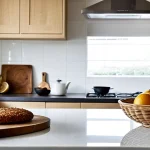Quick wins for healthy habits in a tiny kitchen
Small spaces demand smart strategies to maintain healthy eating in small kitchens. The key is to focus on tiny kitchen healthy habits that require minimal space but offer maximum impact. For example, dedicating a small corner for fresh produce storage encourages daily fruit and vegetable consumption, a cornerstone of healthy kitchen routines.
Simple changes such as replacing processed snacks with chopped veggies stored in clear containers make nutritious options more accessible. This habit not only supports better choices but fits neatly into limited shelving or fridge space. Another quick win is setting up a compact herb garden on a windowsill, which enhances flavor and promotes use of fresh ingredients without crowding counters.
Topic to read : Unlocking space: how uk kitchen design can boost your efficiency
Meal prep can be daunting in tiny kitchens, but adopting a streamlined approach helps. Pre-portioning ingredients for the week in stackable containers saves time and minimizes clutter, aligning neatly with healthy kitchen routines. Using kitchen tools multifunctionally, such as a blender for smoothies and soups, also maximizes utility in small areas.
In summary, embracing tiny kitchen healthy habits that prioritize space-saving and easy accessibility enables consistent, nutritious eating without overwhelming limited kitchen capacity.
Additional reading : Top tips for optimizing storage in a compact uk kitchen
Organizing your tiny kitchen for maximum efficiency
Maximizing efficiency in a tiny kitchen starts with smart storage solutions. Utilize vertical space by installing wall-mounted racks or magnetic strips for knives and utensils. This clears countertop clutter and keeps essentials within arm’s reach. Drawer dividers help organize cutlery and small tools, making it easier to find what you need quickly.
Decluttering is vital. Adopt a one-in-one-out policy for kitchen items to avoid hoarding. Store rarely used gadgets in labeled bins on higher shelves to free up prime space for everyday tools. Regularly assess your kitchen inventory and donate or discard items you no longer use.
Implementing a zone system enhances workflow. Create distinct areas for food prep, cooking, and cleaning. Place frequently used items in their respective zones—like spices near the stove or cutting boards next to the prep area—to reduce unnecessary movement and speed up tasks.
With these small kitchen hacks and kitchen storage solutions, your compact cooking area can feel spacious and functional, turning chores into effortless activities and promoting a more enjoyable culinary experience.
Choosing space-saving appliances and tools
Selecting the best appliances for small kitchens is crucial for creating a functional and efficient cooking space. Focus on compact kitchen gadgets that combine multiple functions, such as a blender with food processor attachments or a toaster oven that also bakes and broils. These tools save counter space while expanding your cooking options.
Energy-efficient, space-saving kitchen equipment is particularly valuable, as it reduces electricity use and keeps your kitchen comfortable during meal preparation. Look for appliances with Energy Star ratings or models designed for small households, ensuring you maintain healthy cooking practices without excess energy consumption.
In limited spaces, thoughtful storage choices enhance accessibility and organization. Use vertical storage solutions, like wall-mounted racks or magnetic strips, to keep frequently used appliances within reach but off the countertops. Stackable containers and collapsible tools also help maximize cabinet space. When selecting compact appliances, consider their dimensions and how easily they fit in your storage areas, balancing convenience with tidiness.
By carefully choosing appliances that offer versatility, energy efficiency, and compactness, you create a kitchen that supports healthy, nutritious cooking even within spatial constraints.
Meal prepping and batch cooking made easy
Finding space for healthy meal prep in small kitchens can feel like a puzzle, but smart organization changes the game. Start by designating a clear prep zone and using stackable containers to maximize limited counter surfaces. Cutting vegetables and proteins in batches before cooking streamlines the process and reduces clutter.
When it comes to batch cooking in small kitchens, portion control becomes vital. Prepare meals in individual servings to maintain freshness and avoid food waste. Using smaller containers not only saves space but also helps in tracking portions easily, supporting balanced nutrition goals.
To stay efficient, rely on visual guides such as labeling containers and color-coding ingredients. This quick reference saves time during busy weekdays and keeps your meal prep organized. Investing in a magnetic notepad or a chalkboard near your workspace can aid in planning meal components and shopping lists.
Overall, effective meal prep organization hinges on mindful use of space and tools. Employ containers that nest efficiently and choose recipes suited for freezing without losing flavor. These tactics empower you to enjoy wholesome meals with minimal kitchen stress.
Fast, nutritious recipes for compact kitchens
Cooking in a small space doesn’t mean sacrificing flavor or nutrition. Easy healthy recipes designed for small space cooking can keep mealtime stress-free and enjoyable. One-pan or minimal-equipment meals are perfect here. They require fewer dishes and simplify cleanup. For example, a stir-fry loaded with seasonal vegetables and lean protein can be made in a single skillet in under 20 minutes.
No-cook and low-prep recipe suggestions further ease the burden on tiny kitchens. Salads with canned beans, leafy greens, chopped nuts, and a quick vinaigrette are excellent for balanced meals without using the stove. Another hack is layering Greek yogurt, fruit, and granola for a nutritious breakfast or snack.
Ingredient swaps and shortcuts help maintain meal variety and nutrition. Frozen vegetables can replace fresh ones, cutting prep time yet preserving vitamins. Using pre-cooked grains like quinoa or brown rice eases assembling quick meals. These techniques in easy healthy recipes and small space cooking empower anyone to create quick meals for tiny kitchens efficiently.
Maintaining motivation and healthy routines
Small changes, lasting impact
Building healthy eating motivation in limited spaces is more feasible than it seems. Begin by establishing simple kitchen routines that fit your available environment. For example, set aside a specific spot for prepping fruits or keep healthy snacks within reach. This helps create consistency and reduces decision fatigue.
Setting clear, achievable goals sparks ongoing inspiration. Consider tracking small wins, like trying one new vegetable weekly or drinking a glass of water before meals. Pair these with creative rewards—perhaps a favorite podcast after cooking or a mini dance break. These incentives keep enthusiasm high without overwhelming your space or schedule.
Real-life success stories often highlight this approach. People living in compact apartments report that just reorganizing their kitchen led to a better healthy lifestyle with limited space. They replaced clutter with essential tools and ingredients, making nutritious cooking easier and more enjoyable. These examples show that even modest adaptations can spark momentum and transform habits sustainably.
Focus on what fits your lifestyle and space. Adapt routines to your unique circumstances, and motivation will follow naturally, creating a positive cycle of healthful, manageable habits.

